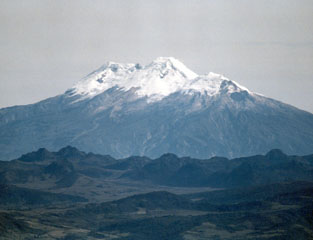Report on Nevado del Huila (Colombia) — 19 November-25 November 2008
Smithsonian Institution / US Geological Survey
Weekly Volcanic Activity Report, 19 November-25 November 2008
Managing Editor: Sally Sennert.
Please cite this report as:
Global Volcanism Program, 2008. Report on Nevado del Huila (Colombia) (Sennert, S, ed.). Weekly Volcanic Activity Report, 19 November-25 November 2008. Smithsonian Institution and US Geological Survey.
Nevado del Huila
Colombia
2.93°N, 76.03°W; summit elev. 5364 m
All times are local (unless otherwise noted)
INGEOMINAS reported an eruption of Nevado del Huila at 2145 on 20 November that destroyed part of a new lava dome that had formed during the previous months. The Alert Level was raised to Red (on a 4-color scale where Red is the highest level). According to the Washington VAAC, two gas-and-ash plumes rose to altitudes of 12.4-15.4 km (40,700-50,500 ft) a.s.l. and drifted W and SE. Hot material erupted at the summit melted areas of the surrounding glacier and caused lahars in the Bellavista and Páez rivers. Lahars in the Páez River damaged infrastructure and destroyed homes, and residents of Taravira, Tóez, and La Estrella reported abundant ashfall and noises associated with both the eruption and the lahar. There may have been as many as 10 fatalities and 10 others were missing, and several populations were left without means of communication. By the time of a report at 0230 on 21 November, the seismicity had decreased. During an overflight, scientists observed a 400-m-diameter crater in the SW area of Pico Central. A lava dome inside the crater was degassing. Intense fumarolic activity was noted from the W end of a crack generated in April 2007. The next day, the Alert Level was lowered back to Orange because seismicity had returned to background levels. INGEOMINAS continued to receive reports of sulfur odors and continuous gas emissions from the summit.
According to news reports, the lahars damaged or destroyed about 70 homes and several bridges, and displaced many families. Hundreds of people were evacuated.
Geological Summary. Nevado del Huila, the highest peak in the Colombian Andes, is an elongated N-S-trending volcanic chain mantled by a glacier icecap. The andesitic-dacitic volcano was constructed within a 10-km-wide caldera. Volcanism at Nevado del Huila has produced six volcanic cones whose ages in general migrated from south to north. The high point of the complex is Pico Central. Two glacier-free lava domes lie at the southern end of the volcanic complex. The first historical activity was an explosive eruption in the mid-16th century. Long-term, persistent steam columns had risen from Pico Central prior to the next eruption in 2007, when explosive activity was accompanied by damaging mudflows.
Sources: Servicio Geológico Colombiano (SGC), Latin America Herald Tribune, EFE News Service

